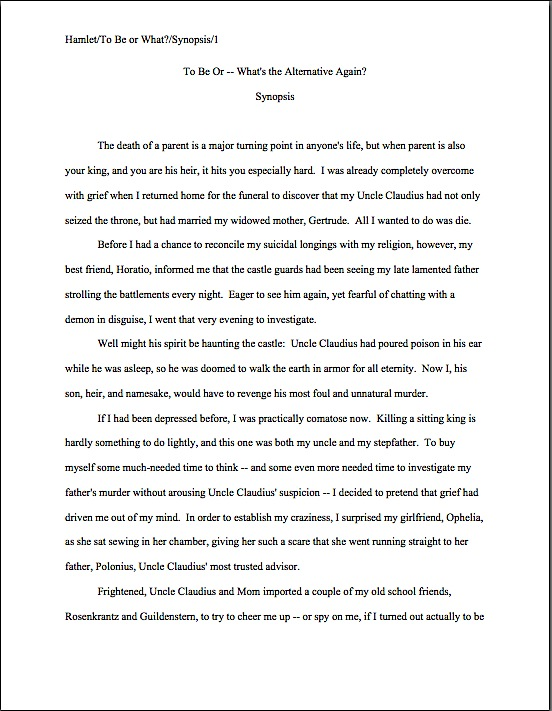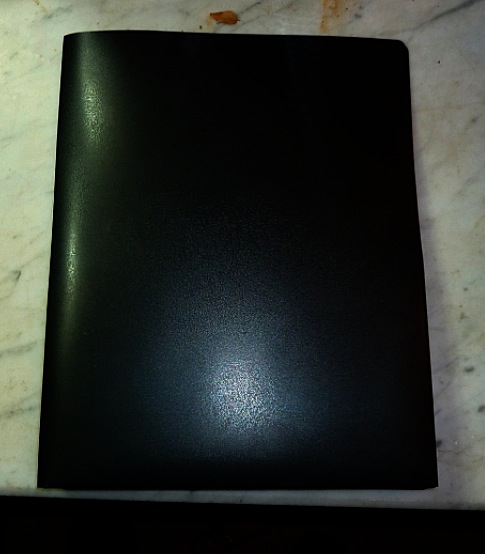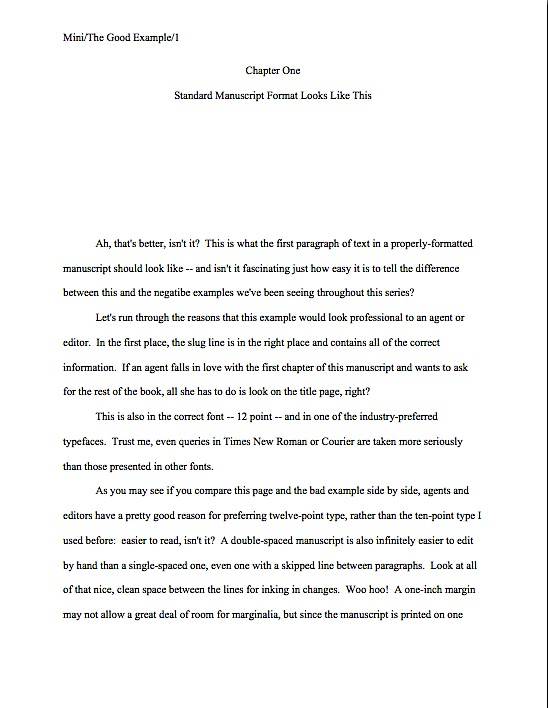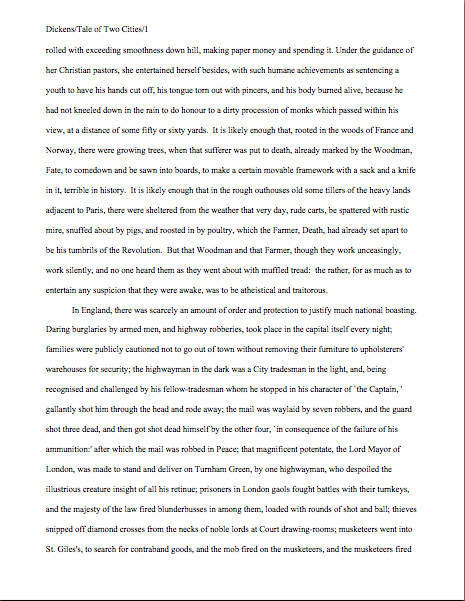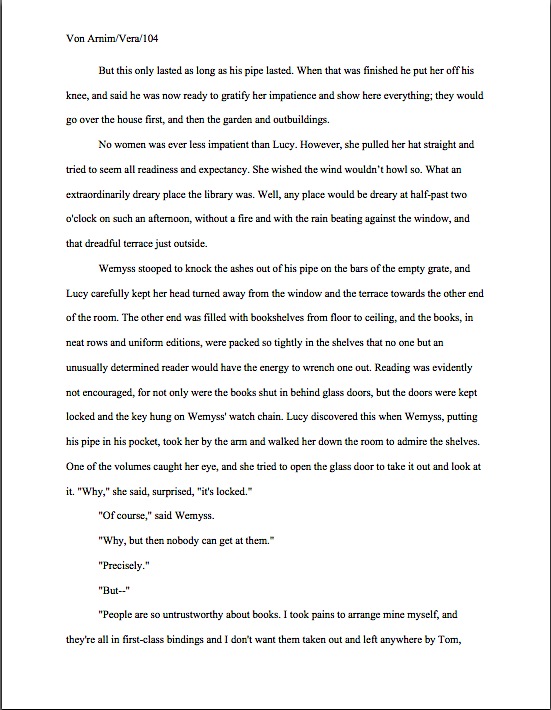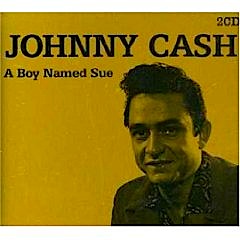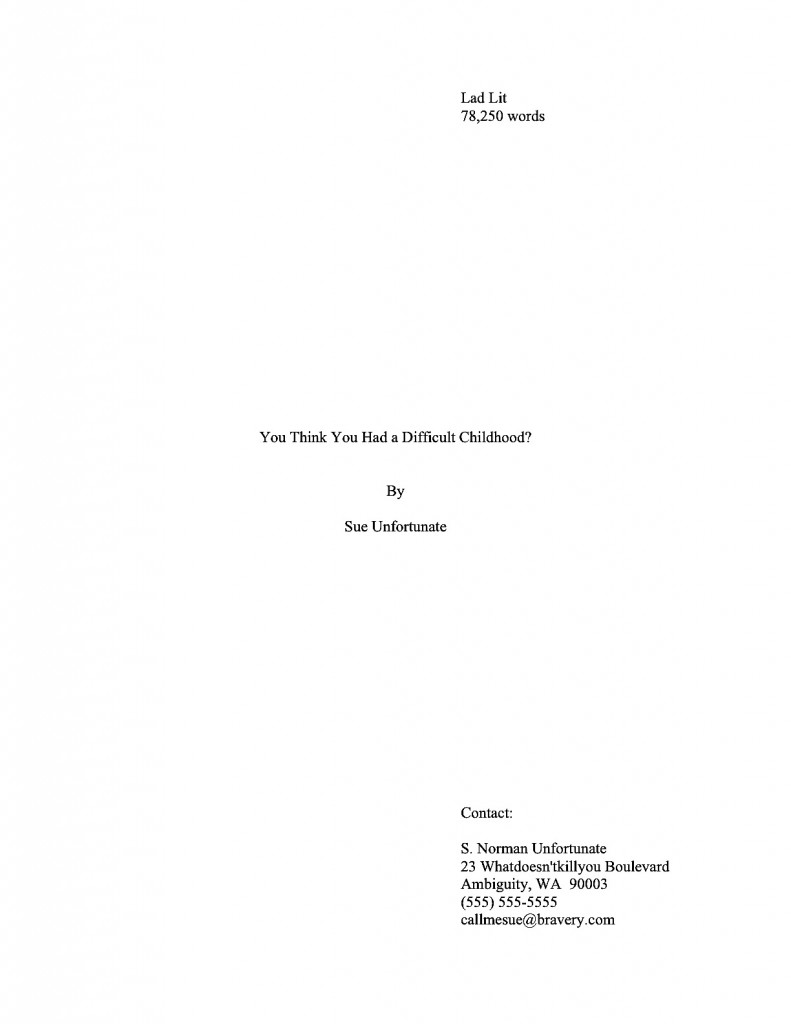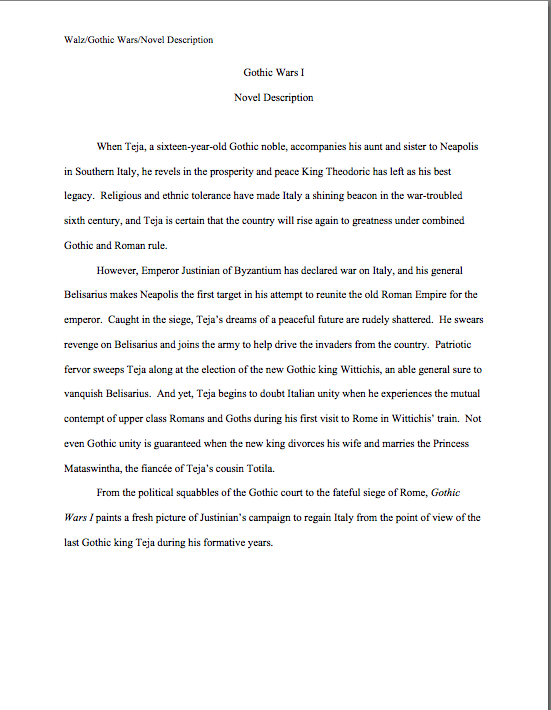Has everyone had time to absorb this week’s earlier post on what a professionally-formatted book manuscript looks like? I realize that for those of you brand-new to presenting your writing to agents, editors, and contest judges, that single-post overview might have run a bit quickly. In the interests of clarity, I’m going to be devoting the next few posts to going over each rule in some detail, for the explanation-oriented.
And yes, you’re quite correct: I’m doing this a bit late this year. In the past, I have devoted the first weeks of each new year to regaling the members of the Author! Author! community with an in-depth look at how professionally-formatted book manuscripts and proposals are put together. Why make this an annual event, you ask? Why, because I’m fond of writers — and I’m constantly meeting good writers new to the biz who haven’t the vaguest idea about what a professional manuscript looks like, for the exceedingly simple reason that they’ve never seen one.
Or, in many cases, ever thought about presentation at all. The vast majority of submitters seem to believe either that how writing looks on a page lies purely within the author’s discretion or that manuscripts and published books should be formatted identically, and these beliefs make their writing look less professional to people who read book manuscripts for a living.
Which, if you think about it, isn’t all that astonishing: hands up, those of you who got into the writing habit because you were just dying to learn all about margins or page spacing. When the Muses sneak up upon us, sprinkle us with inspiration, and send us scurrying toward our writing desks, the consideration of what typefaces an agent might prefer tends not to be uppermost in our thoughts, does it?
You’d never know that, though, from hearing folks who read manuscripts for a living talk about how often they see whimsically-presented writing. “Half of ‘em don’t even bother to spell- or grammar-check,” Millicent the agency screener, Maury the editorial assistant, and Mehitabel the contest judge have all been heard to moan, “let alone proofread. And then they don’t indent their paragraphs, or assume that I’m going to be willing to strain my eyes over 10-point type? Or one that’s single-spaced? There’s no way my boss the agent/the editor for whom I work/the celebrity judge in the finalist round is going to be willing to put up with any of that.”
As professional readers like to say, if a writer’s serious about getting published, she’ll take the time to learn what the formatting norms are. So pervasive is this saying that even amongst the open-minded, there is a deep, pervasive prejudice against manuscripts that don’t look right cosmetically. Millicent, Maury, and Mehitabel are so conditioned to expect professional formatting that when they see a submission that deviates from the rules in any significant respect, they tend to assume, as did the hypothetical tableful of editors above, that the writer is falling down on the job in other respects.
What does that mean in practical terms? Often, that incorrectly-formatted manuscripts and contest entries get rejected on sight — and, in many cases, unread. Why, you ask, aghast? Actually, there’s a pretty good reason: writers unfamiliar with how publishing works tend to be both more time-consuming to work with and more energy-consuming to represent than those who have done their homework. Most agencies, after all, do not sponsor a crash course in professional presentation for new clients (although that’s a darned good idea). Since that’s the case, the simplest way for our old pal, Millicent the agency screener, to tell if a new writer has learned much about the industry s/he aspires to enter is a quick glance at page 1.
Oh, you thought some agencies allowed aspiring writer to include the first few pages of text with their queries just so Millicent could get a sense of their writing style? At minimum, presentation problems will render it more difficult for a good writer to get the aforementioned agents, editors, and contest judges take his work seriously.
Why? Well, think about it: it’s one of the easiest ways conceivable to narrow the submission pool — which is job #1 for Millicent, Maury, and Mehitabel, right? Do the math: if the average agent receives 800-1500 queries per week and agrees to read even five percent of the manuscripts (high for most agents, by the way), that’s 40-60 manuscripts per week, and thus somewhere in the neighborhood of 2,000-3,000 per year.
Since even a very successful agent could take on, at most, 4-5 new clients per year, Millicent had better narrow down that applicant pool, pronto, hadn’t she? So had Maury. So had Mehitabel, since no matter how good a crop of contest entries is, there are generally only a fixed, small number of finalist slots. They’ve got to rule manuscripts out.
Isn’t it fortunate for them, then, that the overwhelming majority of submitters present their writing unprofessionally? They either resemble published books (which is not correct for a manuscript submission), are submitted in short story format (ditto), or look like whatever the submitter happens to think looks nice on the page (extrapolate the answer from the previous two).
All of which makes Millicent, Maury, and Mehitabel shout, “Hallelujah,” especially over the last few years, when both query and submission rates have been skyrocketing. Writing a book has always been plan B for a lot of people — with the economy in its current state, many folks seem to be pulling partially-finished manuscripts out of desk drawers these days. (Okay, off their hard disks, but it amounts to the same thing.) The timing’s a tad unfortunate, since this is also a period where publishing houses have been laying off editors and other staff in droves.
Translation: you know how fierce the competition to get picked up by an agent already was before the economy went south? It’s become even tougher. So I would encourage those of you who are right now muttering angrily that if the world were organized correctly, only the quality of the writing would matter in a submission or contest entry to ask yourselves: even if you’re right, does it really make sense not to give Millicent, Maury, and Mehitabel what they expect to see?
Or, to put it another way: if your goal is to impress these people with your writing, why distract them from it with non-standard formatting?
Then, too, because so many aspiring writers go a bit random with their pages, submitting a properly-formatted manuscript tends to give an aspiring writer a competitive advantage — and that’s equally true, incidentally, whether that writer sends off her baby in hard copy or attaches it to an e-mail. When agencies, publishing houses, and even literary contests request full or partial manuscripts to be sent via e-mail, what they’re almost always expecting is a Word document (in .doc format, by the way, not .docx); unless they specifically say otherwise, few professional readers would be willing to peruse more than a few pages imbedded in an e-mail.
I sense some of you scratching your heads. “Whoa there, Anne!” shout those of you whose minds have been reeling at the very thought of how much time it might take you to reformat your entire book when you already have a request from an agent in hand — as opposed to, say, just hitting SEND as soon as you finish reading this post. “Before I resign myself to sacrificing some of my very scant writing and querying time to rearranging my words on the page, I want to hear more about that competitive advantage you mentioned. What is it exactly that my fellow submitters and/or writing contest entrants might not know, and how precisely may I take full advantage of the fact that you are evidently determined to force this knowledge upon me?”
Excellent questions both, head-scratchers, and ones that richly deserve extensive answers. Here are the hard facts, some of which I hope will sound familiar by now.
(a) There is a an expected standard format to which US-based agents and editors expect book-length submissions and book proposals to adhere, regardless of whether those manuscripts are produced by seasoned pros with many book sales under their belts or those brand-new to the biz, and thus
(b) while deviating from standard format in a small way (or, more commonly, in a multiplicity of small ways) will not necessarily result in knee-jerk rejection, it does tend to prompt those who read manuscripts for a living to take the manuscript less seriously, on the assumption that an aspiring writer who has not taken the time to learn about standard format probably has not honed her craft much yet, either. Given the pervasiveness of this attitude,
(c) using fancy typefaces, including cover artwork, printing manuscript pages on colored paper, and/or any other deviations from standard format in one’s submission is most emphatically not regarded as interesting expressions of the author’s individual point of view, but rather as evidence that the author doesn’t know about (a). On the bright side,
(d) manuscripts submitted in standard format tend to be treated with substantially more respect by agency screeners, editorial assistants, contest judges, and pretty much everyone who happens to read unpublished prose for a living. Despite this fact,
(e) one does occasionally hear agents and editors ask for deviations from standard format; in these cases, an aspiring writer should definitely give them precisely what they ask to see. However,
(f) it’s never advisable to generalize from what one individual says s/he wants into a brand-new trend sweeping the industry. Nor is it a good idea to ape the formatting choices one sees in a published book, because
(g) book manuscripts do not resemble published books in many important respects, for many excellent, practical reasons that I shall be explaining at length throughout this series. That being the case, professional tend to draw unfavorable conclusions about submissions that do aspire to book formatting, much as they do when aspiring writers are not aware that
(h) standard format for book-length manuscripts is not business format — and just using what you learned about short stories won’t do, either. Nor is it necessarily identical to what your word processor’s grammar checker will ask you to do, or even the AP style one sees in newspapers and magazines. None of these will look correct to an agent or editor who deals with book manuscripts; the norms there are very specific.
This may seem nit-picky and irrelevant to the quality of the writing in question, but think about it: if a host asks you to a formal dinner, it’s only polite to wear formal attire; a guest who shows up in flip-flops and a Hawaiian shirt is going to stand out like the proverbial sore thumb. (If it’s not clear to you why that might be problematic, review point b.) Similarly,
(i) when placed side-by-side with professional manuscripts, as a successful submission inevitably will be, an oddly or inconsistently put-together manuscript will stand out as unprofessional, a phenomenon that all too often leads to
(j) most manuscript submissions getting rejected on page 1. Not always because they deviates from standard format — although, had I not yet made this point sufficiently, the vast majority of submissions do — but because an unprofessionally-formatted manuscript already has one strike against it, and who needs that? Ultimately,
(k) it’s just not worth your while to try to fudge your way out of these standards, since the price of a submission’s annoying a professional reader can be so high. And no matter how many times my readers, students, and editing clients ask me if agents, editors, and contest judges are REALLY serious about them, I’m not going to give you permission to ignore any single one of the standard format strictures.
No way. Stop asking, already. I have your best interests at heart, honestly: the aspiring writer who acts upon this information conscientiously is probably producing submissions within the top 2% of what crosses Millicent’s desk on any given day.
Yes, really. I wasn’t kidding last time about how confused aspiring writers can become by the welter of advice swirling about online — or when I mentioned this time that many writers looking to break into the biz simply don’t think about presentation at all.
Why should they? The writing is all that counts, right?
And a forest of hands has spouted out there in the ether. Yes? “But Anne, I heard from a friend who heard from someone in a writers’ chat room that someone heard at a conference that {fill in preferred deviation from standard format here} is THE new thing. Rumor has it that any manuscript that doesn’t adhere to {see previous bracket-filler} will automatically get rejected as old-fashioned. So there.”
One hears this argument quite a lot on line. Which is surprising, really, because almost no matter what rumored change gets fitted into those brackets, I can tell you now that Millicent didn’t get the memo about it
Why would she, unless she happens to work for the agent-who-blogs or editor-who-is-trying-to-be-helpful that promulgated the new advice? Indeed, why would anyone who works with manuscripts for a living go out looking to see what folks outside the industry — or, at minimum, outside her agency — are demanding of writers these days, when the basics of standard format have actually changed very little for decades?
Oh, should I have numbered that one?
Actually, it would be very much against her self-interest to go trolling for such information, because — chant it with me now, veterans of my annual forays into standard format’s underlying logic — it’s so much easier just to assume that submissions that don’t adhere to standard format are inherently unprofessional, and thus (by implication) less likely to contain writing destined to take the publishing world by storm.
To put it bluntly, not relying upon this convenient assumption would slow her per-submission rejection time. That’s well worth considering, as the fine folks who read submissions (and queries) in order to decide who gets a break and who doesn’t are in typically a great big hurry.
These people have a heck of a lot of reading to do on any given day, after all. In the face of that many pieces of paper to plow through, even the reading of eagerly-solicited submissions tends to be awfully rushed: the goal becomes to weed out as many as possible as quickly as possible, rather than seeking out gems. Once a professional reader like Millicent has been at it for a while, s/he will usually develop a knack for coming to a conclusion about a piece of writing within the first paragraph or two.
Sometimes even within the first line or two. (For a fairly frightening run-down of the common first-page rejection reasons, you might want to check out the HOW NOT TO WRITE A FIRST PAGE category on the archive list conveniently located on the lower right-hand side of this page.)
Unfortunately for writers unaware of the rules, a non-standard manuscript is child’s play to spot from the moment a professional reader claps eyes upon it. That can be an extremely serious problem for a submission, because — wait for it — agencies and publishing houses get so many submissions that a screener’s primary goal is to weed out the one she is reading at the moment.
The faster she can do that, the better, to move through that mountain of paper on her desk. So a first page that cries out, “This writer is brand-new to the game and will require quite a bit of your boss’ time to coach into being able to produce a manuscript that an agent would be comfortable submitting to an editor!” is an outright gift to her: she can feel completely comfortable rejecting it at the very first typo, clich?, or word choice she doesn’t happen to like.
Heck, she might not even wait to spot any of the above. She might just say, “Oh, look — non-indented paragraphs. Next!”
Right now, Harry Houdini himself would have extreme difficulty sneaking a non-standard manuscript past an agency screener. Yes, even though he undoubtedly has the world’s best platform to write a book on extricating oneself from tight situations. (And if that last quip didn’t make you groan, if not chuckle, it’s time to brush up on your industry-speak.)
So here, after that long preamble, are the rules of standard format — and no, Virginia, none of them are negotiable. (Really. Stop asking.) If you would like to see what these look like in action, you’ll find abundant visual examples here.
(1) All manuscripts should be printed or typed in black ink and double-spaced, with one-inch margins around all edges of the page, on 20-lb or better white paper.
No exceptions, unless an agent or editor (or a contest’s rules) specifically asks you to do otherwise. And I’m dead serious about using only white paper: ecru paper, no off-white, no Dr. Seuss-type stripes. The example at the top of this post was intended to frighten you.
Yes, buff or parchment can look very nice, now that you happen to mention it, Virginia, but there’s a strategic reason to use bright white paper. Very sharp black-white contrast is strongly preferred by virtually every professional reader out there, probably as a legacy of having read so many dim photocopies over the course of their lifetimes.
The only colored paper that should ever go anywhere near a manuscript is the single sheet that separates one copy of a submission or book proposal from the next, so it is easy for an agent to see where to break the stack. (But you don’t need to know about that until your agent asks you to send 15 copies of your book for submitting to editors. Put it out of your mind for now.)
Nice, clear, dark print is optimal here, so do spring for a new printer cartridge, if you can. You’d be amazed (at least, I hope you would) at how poor the printing quality is on some submissions; I’ve seem pages that looked as though the writer dunked them in a swiftly-flowing river several times before popping them in the mail.
Which is sad, because submissions with poor print quality are — you’re ahead of me on this one, aren’t you? — almost never read. Millie’s already suffering from eye strain.
Speaking of never, never, ever, ever submit a dim photocopy; print out an original every time. Oh, you may chuckle at the notion of sending out a grainy copy, but believe me, any contest judge has seen many, many entries submitted that way.
Mehitabel likes them, actually: for every one that pops up, her reading time is shortened. Any guesses why?
(2) All manuscripts should be printed on ONE side of the page and unbound in any way. For submission to US-based agencies, publishing houses, and contests, the pages in question should be US-standard 8.5″ x 11″ paper.
Yes, this is criminally wasteful of paper, especially when you consider the literally millions of pages of submissions that go flying into the agencies and publishing houses every month. I assure you, if I ran the universe, paper conservation would be the norm, and recycling mandatory.
Last time I checked, though, I was not yet running the universe. If I were, pandas would be plentiful and come in giant, fairly large, and pocket sizes. Ice cream sundaes would have the same nutritional value as platters full of broccoli, and crowds of public-spirited citizens would rush up and kiss purchasers of first-time authors’ books on each cheek.
Also, writers would all be granted an extra month a year in which to write, excellent and inexpensive child care while writing, a cedar-lined cabin on the shores of Lake Michigan in which to do it, and a pineapple upside-down cake on Ray Bradbury’s birthday. Perhaps some hard candies on Truman Capote’s birthday as well, in affluent years, and dancing on Mme. de Sta?l’s.
But since the unhappy reality is that I do not run the universe, we shall all have to live with the status quo.
Unbound means precisely what it says: no binding of any kind. You’d be surprised at how often writers violate the thou-shalt-not-bind rule, including paper clips, rubber bands, or even binders with their submissions. Since agents always circulate manuscripts without any sort of binding, these doohickeys just scream, “I’m unfamiliar with the industry.”
SASE, open wide: here comes a returned manuscript.
The only exception to this rule is a nonfiction book proposal — not the manuscript, mind you, just the proposal. Proposals are typically presented unbound in a black folder, the kind with horizontal pockets. (For tips, please see the aptly-titled HOW TO FORMAT A BOOK PROPOSAL category at right.)
Which doesn’t mean that you aren’t perfectly welcome to print double-sided or bind copies for your own purposes; just don’t show your work to the pros that way. As Author! Author!’s very first commenter Dave tends to chime in — and helpfully — whenever I bring this up, if you wish to make double-sided, 3-hole-punched, be-bindered drafts for circulating to your first readers for ease of toting around, that’s a dandy idea.
But never submit in that manner to a professional reader unless s/he has asked you to do so. Trust me on this one.
(3) The text should be left-justified, not block-justified, as published books, e-mails, business letters, and online writing tend to be.
Many fledgling writers find (3) nearly impossible to accept, as it is one of the most visually obvious ways in which a professional manuscript differs from a printed book. They believe, wrongly, that anything that makes their submission look more like what’s on the shelves at their local library is inherently professional.
In practice, quite the opposite is true. Yes, books feature text that runs in straight vertical lines along both side margins, and yes, your word processing program can replicate that practically effortlessly, if you ask it nicely to do so. Bully for it.
But don’t take advantage of that pleasing capacity, I beg you: the straight margin should be the left one; the right should be ragged, as if you had produced the manuscript on a typewriter.
Translation: the left margin should be straight; the right margin should not. In practice, that means that the left margin will be exactly 1 inch, while the right margin will be no less than an inch on any given line of text. Similarly, while the top margin should be exactly 1 inch, the bottom margin will typically be slightly more, because the spacing between lines of text needs to be constant.
You actually don’t need to fret over measuring any of this out, if you are using MS Word: just set the margins all around to 1″ and the spacing to double, and you will end up with a standard 23-line manuscript page. Don’t worry if the bottom margin is not precisely 1″; remember, the fine folks at Microsoft are not employees of the publishing industry.
(4) The preferred typefaces are 12-point Times, Times New Roman, Courier, or Courier New — unless you’re writing screenplays, in which case you may only use Courier. For book manuscripts, pick one (and ONLY one) and use it consistently throughout your entire submission packet.
Yes, Virginia, even if you have a strong preference for the lettering in your book when it is published. Why? Shout it with me now: MANUSCRIPTS AND PUBLISHED BOOKS AREN’T SUPPOSED TO LOOK THE SAME.
Select one of the fonts above for submission purposes — unless, of course, an agency’s submission guidelines specifically ask for something different. There are a few agents out there who have their own font preferences (usually Courier, and usually because they also represent screenplays), so do check their websites and/or listings in the standard agency guides. As ever, the golden rule of dealing with an agent you want to represent you is give them precisely what they ask to see, not what you would like them to see.
Personally, I would never dream of allowing an editing client of mine to submit a manuscript in anything but Times New Roman, nor would I ever submit any of my work in anything else. It is the standard typeface of the publishing industry, just as Courier is the norm of screenwriting.
A tad silly, you say? Perhaps, but it’s one of the bizarre facts of publishing life that manuscripts in these fonts tend to be taken far more seriously, and with good reason: these are the typefaces upon which the most commonly-used word count estimations are based. (Psst: if you don’t know why you should be estimating the length of your manuscript rather than using actual word count, please see the WORD COUNT category at right.)
I hear you grumbling, lovers of interesting typefaces. Yes, most published books are in typefaces other than Times or Courier — but typeface decisions for published books are made by the publishing house, not the author. Submission time is not the appropriate period for making your preferences known.
For that excellent reason, the chances of Millicent, her boss, or the editor to whom the agent of your dreams will eventually sell your manuscript taking one look at your offbeat typeface choice and exclaiming, “Well, normally, I would find this completely distracting from the writing, but obviously, this gifted writer is using the only chance s/he’ll ever have to discuss the published version with us to make his/her preferences clear. I guess we’d better honor them!” are so close to zero that you’d have to fly in Zeno via a time machine to measure any difference.
Relax, in other words. If you’ll have a chance to talk about what your book will look like in print after a publisher acquires it. Chances are, the people who actually make these decisions will ignore you — typically, only self-publishing authors who get to select their books’ typefaces — but you’re perfectly welcome to air your preferences at the appropriate juncture. They may giggle a little, true, but they might listen. Ditto with the cover and the title, which are — brace yourselves — almost never under the author’s control.
Why? Because these are matters of packaging and marketing, not content.
All of which begs the question, of course: why do word processing programs tempt us so many typefaces from which to choose, if we’re not supposed to use them? Because the people who make word processing programs are not the same people who decide what books get published in North America. Which is why, in case you’re wondering, what Microsoft Word means by word count and what the average agent or editor does are not typically the same thing.
Fair warning: if you are a writer who likes to have different voices presented in different typefaces, or who chooses boldface for emphasis, a submission is not a forum where you can express those preferences freely. Yes, one sees this in a published book occasionally, but I assure you, the choice to indulge in these formatting differences was the editor’s, not the author’s.
Sorry. See my earlier disclaimer about proprietorship of the universe.
I’m sensing a bit of dissention out there, but I can’t say I’m surprised. Almost invariably, around the time that I bring up Rule #4, someone posts a comment informing me huffily that website X advises something different, that this agent said at a conference she doesn’t care what typeface you use, that a certain manual said that standards have changed from the traditional guidelines I set out here, or some other observation presumably intended to make me rend my garments and cry, “Finally, I see the error of my ways! I guess I’ll disregard the fact that I’ve never seen the change you mention actually in use in a professional manuscript and declare it to be the new norm!”
To save you the trouble: it’s not gonna happen. Arrange for me to get my way about the pandas, and we’ll talk.
More of the rules of standard format follow next time, of course, as well as acres more explanation. Until we meet again, keep up the good work!








